- FMA
- The Fabricator
- FABTECH
- Canadian Metalworking
Categories
- Additive Manufacturing
- Aluminum Welding
- Arc Welding
- Assembly and Joining
- Automation and Robotics
- Bending and Forming
- Consumables
- Cutting and Weld Prep
- Electric Vehicles
- En Español
- Finishing
- Hydroforming
- Laser Cutting
- Laser Welding
- Machining
- Manufacturing Software
- Materials Handling
- Metals/Materials
- Oxyfuel Cutting
- Plasma Cutting
- Power Tools
- Punching and Other Holemaking
- Roll Forming
- Safety
- Sawing
- Shearing
- Shop Management
- Testing and Measuring
- Tube and Pipe Fabrication
- Tube and Pipe Production
- Waterjet Cutting
Industry Directory
Webcasts
Podcasts
FAB 40
Advertise
Subscribe
Account Login
Search
Versatile hydraulic presses perform compression molding Q&A
4 OEMs offer guidance
- January 24, 2018
- Article
- Bending and Forming
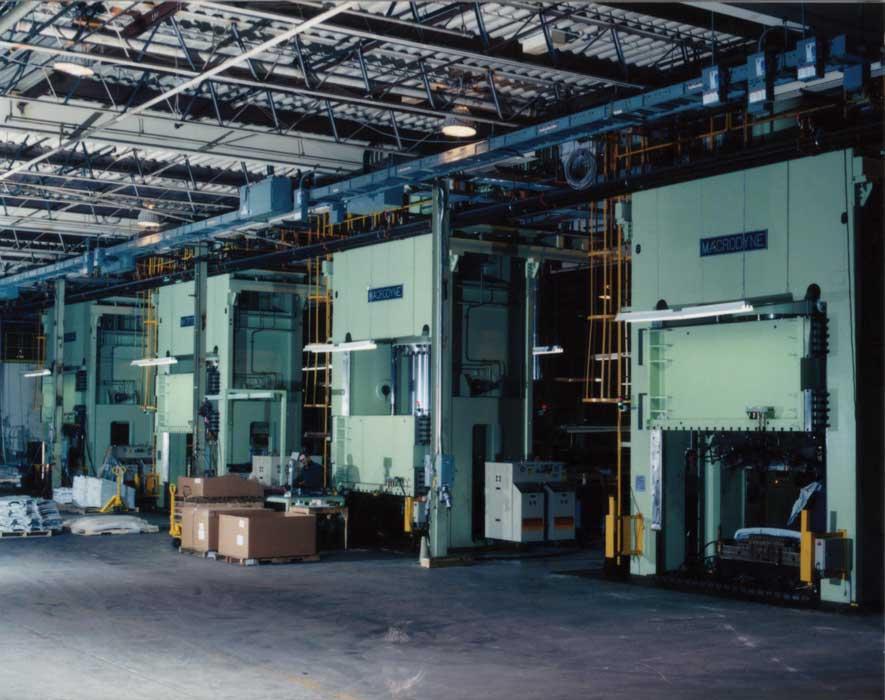
Several 2,000-ton compression molding hydraulic presses produce automotive body parts. Stamping manufacturers already familiar with hydraulic presses might find it useful to know that the presses also can be equipped to perform compression molding. Photo courtesy of Macrodyne Technologies. Concord, Ontario, Canada.
Stamping manufacturers may be surprised to learn that they can perform compression molding of plastic, composite, and advanced materials using a familiar machine—a hydraulic press. Its ability to dwell at bottom dead center and other capabilities make it suitable for compression molding.
Several hydraulic press original equipment manufacturers (OEMs) have been selling the presses to manufacturers for that purpose for years … which begs the question: Can stampers that have been forming metal on hydraulic presses expand their capabilities by doing compression molding on these machines as well? Can they use the same presses they have to perform compression molding also?
Macrodyne Technologies Vice President of Operations Jeremy Neil; Greenerd Press & Machine Co. Inc. Applications Engineering Manager Thomas M. Lavoie; Beckwood Press Co. Director of Sales & Marketing Josh Dixon; and Schuler Inc. Sales and Product Manager, Hydraulic Press Systems Paul Thom delve into the mechanics and intricacies of a compression molding press to answer that question.
STAMPING Journal®: How is a hydraulic press that is engineered for compression molding different from one that is made for metal stamping? How is it “outfitted”?
Jeremy Neil, Macrodyne: Hydraulic presses are versatile and are used for various manufacturing processes to form or fabricate materials including wood, rubber, laminates, and plastics, as well as metal. The hydraulic presses used in different processes are similar in many ways to the hydraulic presses used in metal stamping. Fundamentals such as frame structures and overall equipment composition, deflection criteria, and safety systems are common to both a hydraulic press that is engineered for compression molding and one that is designed for metal stamping.
There are a few differences in process-specific nomenclature. For example, what is called a die in metal stamping is referred to as a mold in compression molding. The slide or ram in metal stamping is referred to as a moving platen in compression molding. Some compression molders refer to the press bed or bolster plate as the base platen, lower platen, or fixed platen—of course, unless the press is equipped with a rolling bolster arrangement that allows the bolster to move in and out of the press to aid in die change and maintenance.
Some of the primary differences relate to the guiding systems, hydraulic and electrical control packages, process-specific features, and the composition of the pressing cycles.
Typically, the guiding arrangement for a metal stamping press will use adjustable eight-point gib guiding, while a hydraulic compression molding press uses prismatic, temperature-compensated guiding. While both guiding arrangements are precise, robust, and fully adjustable, the prismatic, temperature-compensated guiding can maintain specified guide clearances throughout the range of increased temperatures found in compression molding applications.
Specific features and functionality for hydraulic compression molding presses vary considerably depending on the process, but some examples are core/ejector packages, hydraulic accumulator packages for enhanced pressing speeds, in-mold coating (IMC) systems, platen- or mold-heating packages, platen locking systems, intelligent parallel leveling, and vacuum systems (see Figure 1).
To accommodate the thermal heat transfer that occurs from the molds to the press, hydraulic compression molding presses can be equipped with insulation between the upper and lower mold halves and the upper (moving) and lower platens, respectively. Alternatively, hardened wear plates with insulation can be installed between the T-slots of the platens.
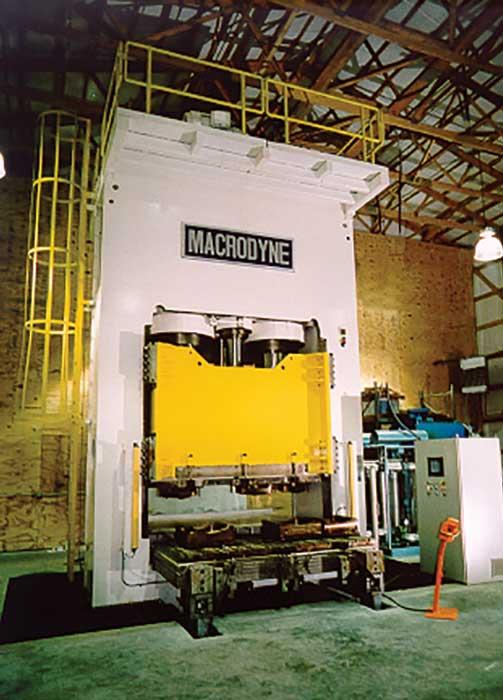
Figure 1
Some hydraulic compression molding presses, such as this one, include a vacuum system. Photo courtesy of Macrodyne Technologies.
If a compression molding press is designed for applications in which enhanced platen parallelism is required, such as in-mold coating for components that require Class A surface finishes, intelligent parallel leveling can be supplied with the press. These intelligent parallel leveling packages are technologically complex and feature high-speed, servo-proportional controlled leveling cylinders, powered leveling spindles, and associated electronic control packages.
The hydraulic and electrical/control packages for a compression molding press are designed to provide fast pressing cycles and integration with any required ancillary process equipment. Generally, the comprehensive control features include programmable pressure, stripping tonnage settings, velocity and pressure profiles, position control and monitoring of the moving platen, auxiliary valve functions, safety interlocks, multimode capability, and programmable dwells. Additional features include job functions, part parameter storage, fault diagnostics, data acquisition package, and preventive maintenance monitoring and assistance.
The control package for the thermal oil heating unit can be stand-alone or directly integrated into the press’s main control system, depending on the application or end user’s preferences.
The control system also may include monitoring and control of the mold heating, parallel-leveling control, vacuum integration, in-mold coating capability and interface with an in-mold coating system, and integration with automated loading and unloading systems.
Josh Dixon, Beckwood: Although we design and build every press differently based on our customer’s specific application, a few characteristics are common throughout most compression molding presses. First, they typically are equipped with heated (and sometimes cooled) platens (see Figure 2). The most common method of heating platens is to use electric cartridge heating rods. Additional heating methods include steam, water, and hot oil (see Figure 3). The platens are divided into a grid of heating zones that are controlled individually and equipped with a designated thermocouple to provide temperature feedback to the heat controller. The number and size of the zones are dictated by the temperature tolerance (accuracy) across the surface of the platen that the application requires.
When platen cooling is required in conjunction with heat, the preferred method is shop air and chilled water. The chilled water can come from the manufacturer’s existing water source, or the press can be equipped with a closed-loop chiller. At the completion of the heating cycle, a combination of air and water is pumped into gun-drilled channels until the platens cool to the designated temperature. The combination, flow rate, and sequencing of the air and water are configurable and customizable based on the timed cooling requirements and the starting temperature of the platen.
In addition to heated and cooled platens, a compression molding press’s hydraulic circuits are designed to allow the ram to dwell. Dwell is an industry term that describes the holding of pressure on a part and mold for an extended, programmable period of time. In applications that require long dwell cycles, a small, pneumatically powered hydraulic pump is integrated into the hydraulic circuit, allowing the primary electric motor and pump to be turned off during the dwell. This minimizes electrical power consumption and reduces operating noise.
Paul Thom, Schuler: A hydraulic press for compression molding needs to stay under pressure at the bottom dead center for a certain time, which, by default, is not possible in a mechanical press. But standard hydraulic metal stamping presses need some special adaptions and functionalities to perform compression molding.
First, compression molding processes require a parallelism control system because of the eccentric loads that result from the high viscosity of resin and the eccentric center of force (see Figure 4).
In addition, the guiding system needs to be able to resist thermal expansion, as the molds are heated to a temperature that strongly depends on the process and material.
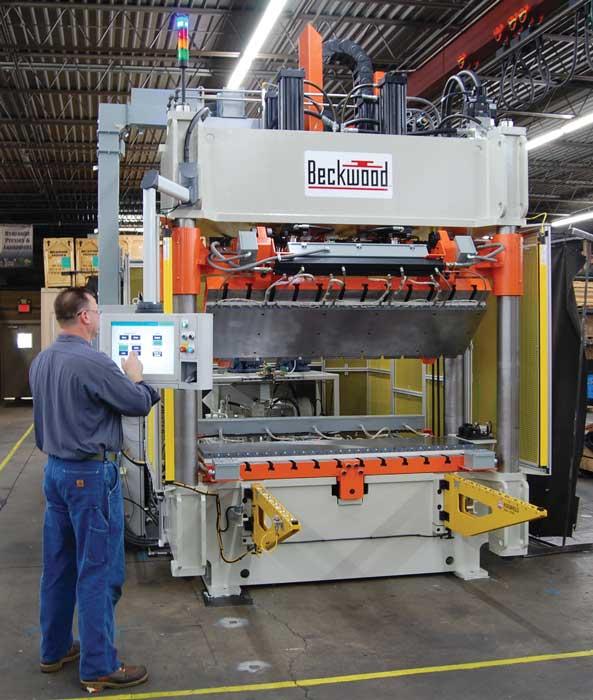
Figure 2
Compression molding presses are equipped with heated platens, which are divided into a grid of heating zones that are controlled individually and equipped with a designated thermocouple to provide temperature feedback to the heat controller. This one has five heating zones per platen. Photo courtesy of Beckwood Press Co., St. Louis.
Third, because the compression molding processes require additional equipment with an interface to the press, such as a high-pressure resin transfer molding (HP-RTM) mix and dosage machine, and special control system functionalities like gap injection for the compression RTM process, the control system must be altered significantly.
Tom Lavoie, Greenerd: In terms of the frame design, you typically see either a four-column press or a
straight-side (slab-side) press for compression molding applications (see Figure 5). The reason for this is that all the deflection of the frame remains straight up and down. In metal stamping applications, it is common to use a C-frame type of press. It is not as common in the compression molding industry, however, because the frame can yawn, which can cause uneven material thickness in the molded part.The available daylight (when the slide is fully open) and stroke of a compression molding press can vary significantly from a metal stamping press, depending on the molded part’s geometry and depth. A deep part requires a larger daylight opening and stroke combination than a typical stamping press has. However, if a stamping manufacturer is doing deep-draw work on its current presses, then those presses are much more adaptable to also doing compression molding. Not only does a typical draw press have a larger daylight and stroke, but it is equipped with some of the necessary hydraulics and controls for dwelling under pressure and speed control on the slide movement as it is being closed and pressure is being applied to the product.
STAMPING Journal: How is a compression molding hydraulic press used differently?
Thom, Schuler: Depending on the chosen process, the requirements in terms of speed, force, and so forth are completely different.
Some processes require very fast closing, forming, and pressure buildup to prevent cooling down of the material, as this could lead to cooling marks and an increased scrap rate. This is especially important for the processing of thermoplastic material.
Other processes, like HP-RTM, have low requirements in terms of speed but very high requirements in terms of precision for an accurate gap of the injection process to increase the injection speed and reduce the total cycle time. Depending on the processes, the auxiliary equipment, such as the oven, HP-RTM mix, and dosage machine, has to be adapted.
Neil, Macrodyne: A hydraulic compression molding press is used differently than a metal stamping press by the manner of its pressing cycle and integration with associated ancillary process equipment, as described previously. A compression molding press has unique velocity profiles to control the material flow and pressure profiles to fill out the mold and cure the part. Stripping profiles are used to prevent damage to the part during stripping.
A compression molding press is capable of fast pressing cycles to ensure maximum production output and also to prevent buildup of residual stresses in the parts that can result from increased material viscosity as the press closes.
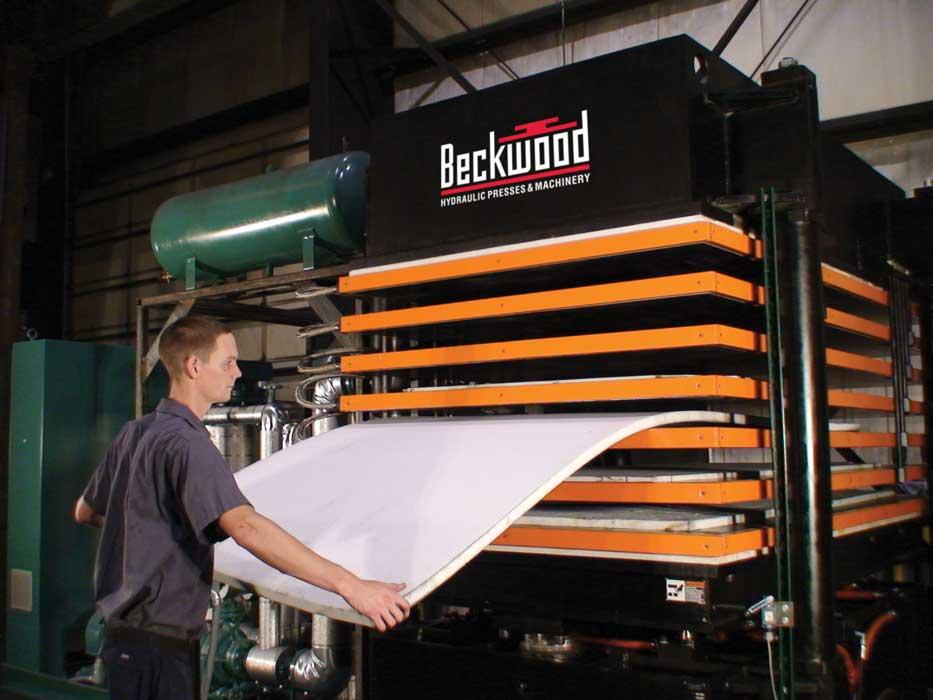
Figure 3
The methods for heating platens include electric cartridge heating rods, steam, water, and hot oil, as shown here. Photo courtesy of Beckwood Press Co.
Two common compression molding applications are sheet molding compound and bulk molding compound. Typically, the control systems for hydraulic presses used for these applications include 10 complex profile curves to control the velocity, pressure, and stripping required to produce the finished part. This capability allows for precise control of both the multiple pressing and stripping speeds and multiple pressing and stripping tonnages required during a single pressing cycle.
Lavoie, Greenerd: Unlike your typical stamping press that is best used in an automatic mode to produce many parts per minute, generally, a compression molding press will tend to produce significantly fewer parts overall.
Typically, a stamping press uses a short stroke without any dwell in the cycle, whereas a compression molding press uses a longer stroke and requires other functions during the stroke. Compression molding presses can dwell for under a minute to upwards of 16 hours, depending on the material being molded and its mass.
For instance, during the molding process, gases can be generated within the mold, and this could affect the part in a detrimental way. It is common for the molding press to have a degassing position or positions to reduce pressure from the mold so that the gases can be evacuated. Sometimes the mold itself will have a vacuum setup, which can also reduce the gases within.
It also is common for compression molding presses to be equipped with heated platens. Some of them include cooling channels to allow the material to cool to a specific temperature during the molding process and upon completion of the dwell cycle, allowing the part to cure.
Various advanced materials today require the press to have complete control over the hydraulics and how they are applied to each material. Some presses need to provide a ramping ability. This allows the pressure on the part to be gradually increased to achieve a specific depth.
A “fast open,” common in a stamping press, could cause the part to split or crack. Often, compression molding presses allow for the mold to open slowly so as to not damage the molded part. A “slow open” allows the upper half of the mold to pull away with minimal pressure from the lower half of the mold. It also is common to have some type of auxiliary ejection system in the upper half of the mold that pushes the part off the upper mold and retains it in the lower mold half.
Unlike a stamping press, in which the objective is to cycle as fast as possible to achieve maximum cycles per minute, the molding press is equipped for complete control over how the press operates, and cycle times can be in minutes or hours.
Dixon, Beckwood: The most distinguishing features of a compression molding press relate to programming and electrical communications. In many compression molding applications, the press must communicate with external devices such as vacuum pumps, resin dispensing equipment, and thermocouples embedded into the tool. The press’s programmable logic controller (PLC) is responsible not only for being the “brain” of the press, but also for driving the overall process. Also, data acquisition systems are commonly used to monitor and record force, position, time, temperature, and other operating parameters in real time for data analysis and record tracing. At the completion of a pressing cycle, the data can be stored in the machine or transferred to a customer-specified network location via Ethernet automatically.
STAMPING Journal: Can one hydraulic press be used both for metal stamping and compression molding?
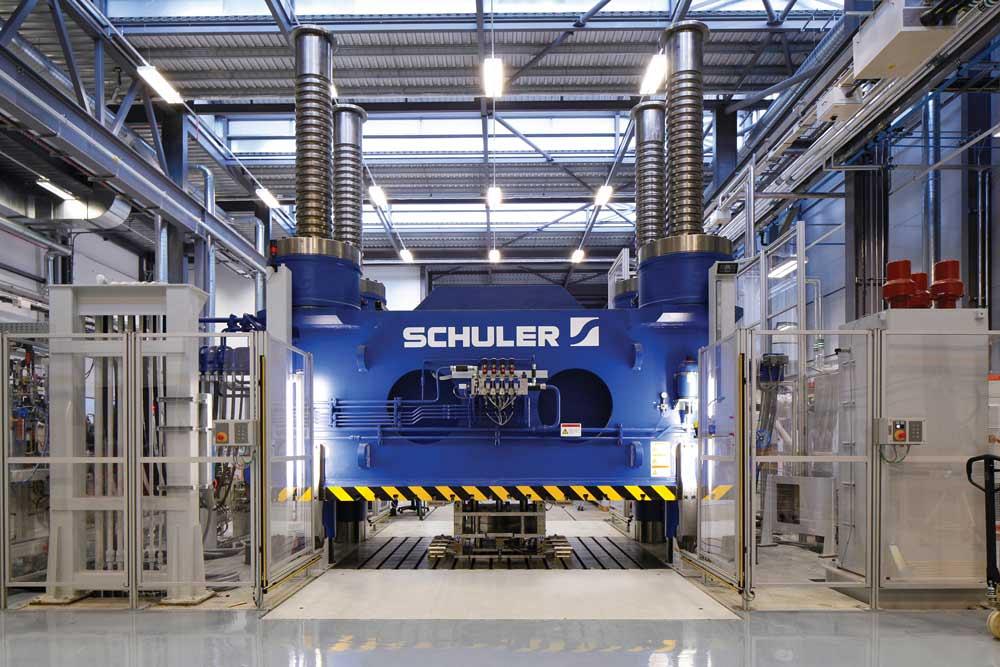
Figure 4
Compression molding processes require a parallelism control system because of the eccentric loads that result from the high viscosity of resin and the eccentric center of force. In addition, the guiding system needs to be able to resist thermal expansion. Photo courtesy of Schuler Inc., Canton, Mich.
Thom, Schuler: Generally yes, but then it should be a compression molding press that will be used for metal stamping to make sure the special requirements are fulfilled. Of course, in that case there also might be some limitations, because compression molding presses don’t have a cushion. So if there is no need for a cushion, a compression molding press is the right choice for both technologies. If a cushion is required, it is probably better to go for a metal stamping press and make the necessary adaptions like parallelism control in the guiding system.
Neil, Macrodyne: Generally speaking, a hydraulic press that was designed for metal stamping can be used for compression molding applications also, provided that the process is relatively basic and that the existing control package for the metal stamping press is advanced enough to accommodate the process. (Our standard metal forming press control packages are.) For example, position encoders would be required, and the existing control system would need to be capable of programming multiple simple, discrete steps to mimic more advanced velocity and pressure profile curves.
If a metal stamping press were to be modified for a compression molded application, it would need to incorporate mold temperature monitoring and control, which has a relatively minor additional cost. Provided that the press was equipped with eight-point gib guiding, some form of insulation could be added, negating the need to modify the existing guiding arrangement.
However, if the compression molding process were very advanced, had complex requirements, and required intelligent parallel leveling, careful consideration would be required. Retrofitting an existing press under these circumstances may be financially and physically prohibitive compared to specifying a new custom press—especially if the process requires enhanced platen parallelism. An additional intelligent parallel leveling package can take up valuable, usable die (mold) space needed to accommodate leveling cylinders and spindles.
Alternatively, if a manufacturer wanted to have the flexibility to use a press for both applications without having to compromise optimization in any areas of the process or equipment itself, a new hydraulic press could be designed to accommodate both applications that would integrate the mechanical, hydraulic, and electrical componentry required for both applications. Furthermore, the press could be equipped with a customized dual-control system, including two separate PLC and operator-interface programs–both of which could be optimized for the manufacturer’s specific metal stamping and compression molding applications.
Lavoie, Greenerd: A typical stamping press probably is not the best press for trying to perform compression molding. However, as mentioned earlier, a deep-draw press with the ability to alter the press speed and to control stroke functions, times, or heights could be used for compression molding applications.
These presses would need the ability to dwell for minutes, if not hours, depending on the advanced material being molded. A simple deep-draw press that does not have a human-machine interface could be converted to have one, allowing for more control over the press functions needed to perform the molding operations.
Dixon, Beckwood: One advantage of a hydraulic press (particularly presses that are built to suit) is the versatility that is inherent to the machine. Our presses can be designed to be used for both stamping and compression molding if the manufacturer desires.
Although machine characteristics may differ between the two applications, these differences can be turned on or off to meet application requirements. For example, the platens can be heated while compression molding, but can also be turned off to act as an ambient-temperature bed and ram bolster during stamping operations. Dwell cycles that may be unnecessary for stamping applications can be set to zero, allowing the ram to return to the position or pressure needed.
Beckwood Press Co., www.beckwoodpress.com
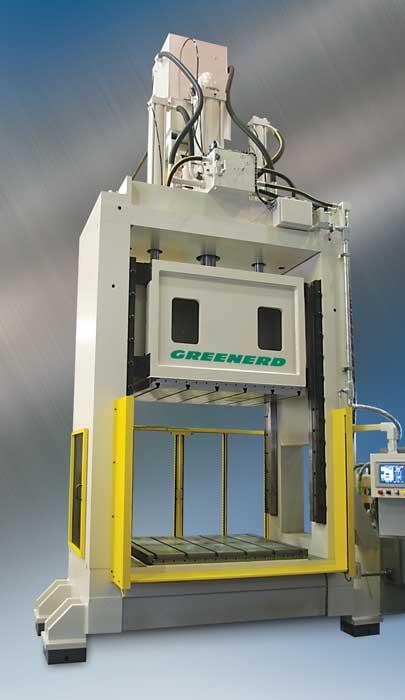
Figure 5
Compression molding presses have either a four-column or a straight-side frame design—such as this eight-point, gib-guided straight-side hydraulic press, which is designed for both metal forming and compression molding and built to withstand the straight up and down motion. Photo courtesy of Greenerd Press & Machine Co. Inc., Nashua, N.H.
Greenerd Press & Machine Co. Inc., www.greenerd.com
Macrodyne Technologies Inc., www.macrodynepress.com
Schuler Inc., www.schulergroup.com
subscribe now

The Fabricator is North America's leading magazine for the metal forming and fabricating industry. The magazine delivers the news, technical articles, and case histories that enable fabricators to do their jobs more efficiently. The Fabricator has served the industry since 1970.
start your free subscription- Stay connected from anywhere

Easily access valuable industry resources now with full access to the digital edition of The Fabricator.

Easily access valuable industry resources now with full access to the digital edition of The Welder.

Easily access valuable industry resources now with full access to the digital edition of The Tube and Pipe Journal.
- Podcasting
- Podcast:
- The Fabricator Podcast
- Published:
- 04/16/2024
- Running Time:
- 63:29
In this episode of The Fabricator Podcast, Caleb Chamberlain, co-founder and CEO of OSH Cut, discusses his company’s...
- Industry Events
16th Annual Safety Conference
- April 30 - May 1, 2024
- Elgin,
Pipe and Tube Conference
- May 21 - 22, 2024
- Omaha, NE
World-Class Roll Forming Workshop
- June 5 - 6, 2024
- Louisville, KY
Advanced Laser Application Workshop
- June 25 - 27, 2024
- Novi, MI































